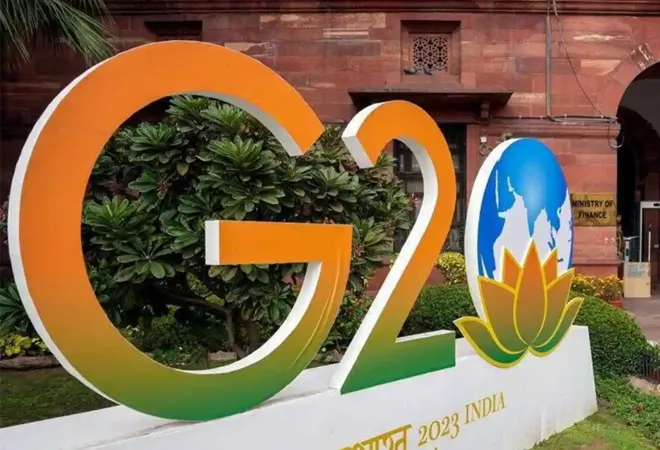
India’s
G20 presidency is in full swing with events and deliberations taking place all across the country on the key global challenges of the day. Yet, there is no denying the fact that India is presiding over a deeply divided G20 amidst a global economic crisis that is hampering post-pandemic recovery.
As if the pre-existing United States (US)-China strategic competition, the COVID-19 pandemic, and climate-induced disasters were not enough, Russia’s war on Ukraine has triggered an unprecedented food and energy crisis alongside soaring inflation. These global shocks are disproportionately impacting countries of the Global South—these include countries in Asia, Africa, and Latin America which are poorer and less developed, many having a colonial history—over the Global North—the wealthy and economically developed countries such as the US, Europe, Canada, etc.
It is true that developing countries are particularly vulnerable to current food shortages, debt crises, and problems of inequality and poverty. As Prime Minister Narendra Modi
stated, “Most of the global challenges have not been created by the Global South, but they affect us more”. Indeed, only in 2022, over 50 countries
resorted to the International Monetary Fund for financial support.
A little over a month after assuming the leadership of the G20, India convened a virtual summit bringing together 120 countries of the Global South—an important move aimed at involving countries that are not part of the G20 but equally, if not more, affected by global challenges.
In this regard, India aims to
champion the concerns of the Global South and amplify its voice during its G20 presidency. In fact, India has a long history of spearheading leadership of the Global South. In the years following its independence, India pioneered the Non-Alignment Movement to ensure more room to manoeuvre and wider options for developing countries to avoid becoming embroiled in the great power politics of the time, while championing third world solidarity.
On 12-13 January, 2023, a little over a month after assuming the leadership of the G20, India convened a virtual summit bringing together 120 countries of the Global South—an important move aimed at involving countries that are not part of the G20 but equally, if not more, affected by global challenges. This summit sent out the message that even countries beyond the G20 members have a stake in India’s presidency with their inputs being valued since the topics under the forum's ambit pertain to all nations. Besides, as the current troika of G20 presidencies comprises emerging economies Indonesia, India, and Brazil, it is natural that priorities of the Global South would garner more attention.
Yet while furthering the joint causes of the Global South, India must also ensure that it has the Global North on board. For its G20 presidency to be successful, it would be useful for India to adopt a two-pronged approach—prioritise the causes of the Global South but even more importantly, attempt to bridge the North-South divide.
Bridging the North-South Divide
Diversity remains the G20’s greatest strength based on its wider representation and relative inclusivity, compared to other international forums, that nations across both the Global North and South. However, this strength often becomes a liability as countries in the Global North and South do not always see eye to eye on many key policy areas owing to unequal development levels and even historic legacies.
The G20 countries need to come together to work towards unified solutions; focusing too much on the Global South risks perpetuating a further divide into an already fraught forum, especially when solutions for Global South issues require partnering with the Global North.
In most priority areas that India’s G20 presidency seeks to address, the North-South divide is palpable. On the issue of multilateralism, countries in the Global South lament their exclusion from multilateral structures such as the United Nations Security Council, while the Global North prefers to maintain the status quo from which it benefits. In climate and energy-related debates, concerns around differentiated responsibility and funding have led to a deep-rooted North-South divide; whereas on issues of digitalisation, the divide between the developed and developing world continues to widen. Even on the Russia-Ukraine crisis, while some G7 members are keen to expel Russia from the G20, countries in the Global South have maintained their ties with the country. These divergences make it difficult to arrive at a consensus in the G20, often hampering collective action and resulting in stalemates on several issues. Thus, in order for the G20 to remain effective, arriving at consensus and ensuring compatibility between these two sets of countries is imperative.
The G20 countries need to come together to work towards unified solutions; focusing too much on the Global South risks perpetuating a further divide into an already fraught forum, especially when solutions for Global South issues require partnering with the Global North. For instance, climate and energy transitions in developing countries require technology and capital transfers from the developed world.
In this context, India can act as a ‘bridge’ between the Global North and Global South.
For a variety of reasons, India is uniquely positioned to assume this role—it has close partnerships with most countries in the Global North that it can harness during its presidency, while its challenges resonate with those facing the Global South. As EAM Jaishankar
highlighted, “India is a South Western power with very strong bonding with the developed world, which would enjoy as it goes up in the international order, the degree of trust and confidence of other developing states”. Simultaneously, India has also performed well on several fronts that feature as priorities during its presidency such as inclusive digital infrastructure and climate change, making its story a credible one for other developing countries to follow. During a period of recessionary global economic trends, India continues to be an economic bright spot.
India is uniquely positioned to assume this role—it has close partnerships with most countries in the Global North that it can harness during its presidency, while its challenges resonate with those facing the Global South.
A relatively successful example of North-South cooperation is the cooperation between India and Europe where the two already work together on several priority areas that have been identified for India’s presidency. For instance, climate change and energy transitions have become central to the EU-India partnership where India has several cooperative agreements with both the European Union such as the
EU-India Clean Energy & Climate Partnership as well as several bilateral pacts with member states including
France,
Italy,
Germany—all of which are also G20 members. These are enabling India and Europe’s green ambitions to bear fruit while also delivering on international commitments. This demonstrates that despite divergences, not only is North-South cooperation possible, but it is also an important prerequisite to addressing global problems and ensuring the continued relevance of the G20.
Blurred North-South Lines
The world today is markedly different from the era of the 1960s and 70s when the lines between the Global North and South were more defined and when several nations in the Global South had not yet economically liberalised. Today the so-called Global South itself s a diverse polity ranging from China which currently holds the status of the world’s second-largest security and economic power, to African countries which continue to be plagued by a myriad of problems, to the dynamic economies of East Asia, to India which is the world’s fifth-largest economy, and to Pakistan and Sri Lanka which are riddled by debt crises. These wealth and power differentials also mean that the challenges, approaches, and needs of these countries remain diverse without a coherent common agenda binding them. Besides, several current plurilateral arrangements such as the QUAD, I2U2, BRICS, and not least the G20 itself, have a cross-cutting membership ning the Global North and South. Thus, it is questionable whether a simplistic North-South conceptual framework is even applicable in the present age.
During its presidency, India will have to intensely navigate and negotiate to ensure cooperation between members to result in meaningful outcomes on key issues and implementation of reforms. It would serve New Delhi well to take a leaf out of its own multi-aligned approach during the Russia-Ukraine crisis that has enabled it to remain amongst the few world nations with close partnerships with all sides, as well as its other recent collaborative approaches to global issues such as its
vaccine and drug diplomacy during the peak of the COVID-19 pandemic.
Generating solidarity through a consensus-building approach while ensuring all nations remain on board would allow India to stay true to its presidency’s inclusive theme of “One Earth, One Family, One Future”.
The views expressed above belong to the author(s). ORF research and analyses now available on Telegram! Click here to access our curated content — blogs, longforms and interviews.



 India’s
India’s  PREV
PREV



